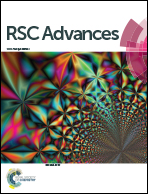Winolides A–C, bioactive sesquiterpene lactones with unusual 5,6-secoeudesmane frameworks from Inula wissmanniana†
Abstract
Winolides A–C (1–3), three bioactive sesquiterpene lactones with irregular 5,6-secoeudesmane frameworks, which probably arise from different dienol-benzene rearrangements, were isolated from Inula wissmanniana. Their structures and absolute configurations were established by extensive analysis of spectroscopic data, computational methods, and asymmetric synthesis.


 Please wait while we load your content...
Please wait while we load your content...